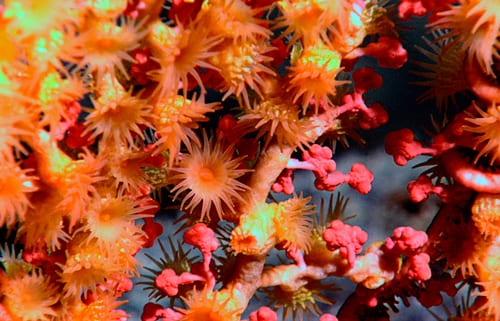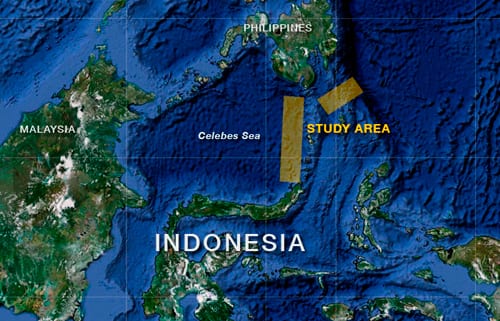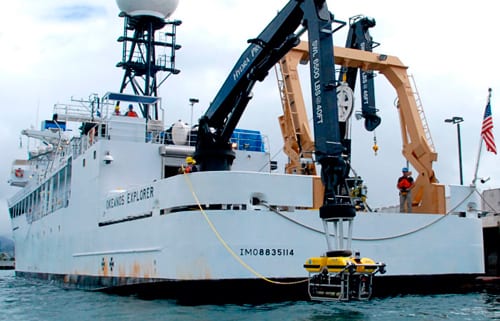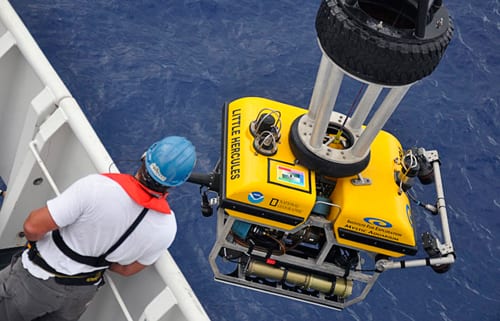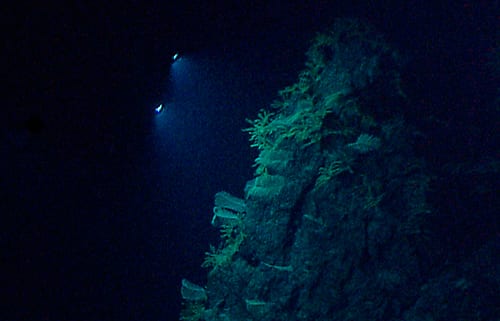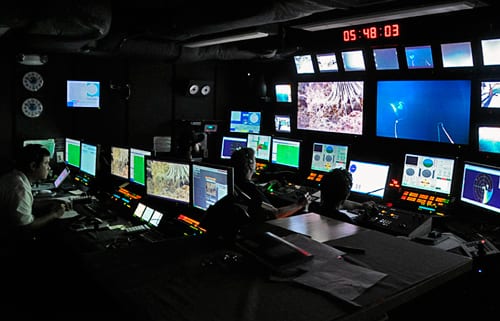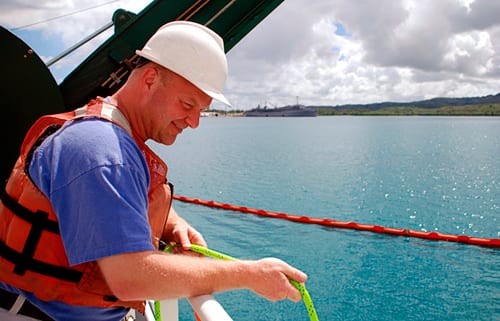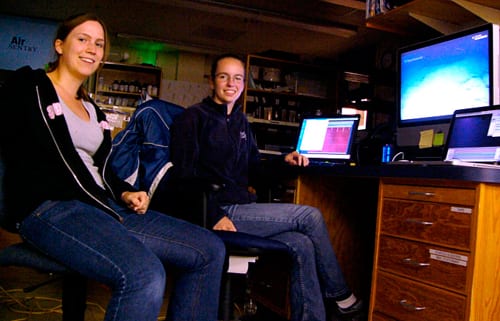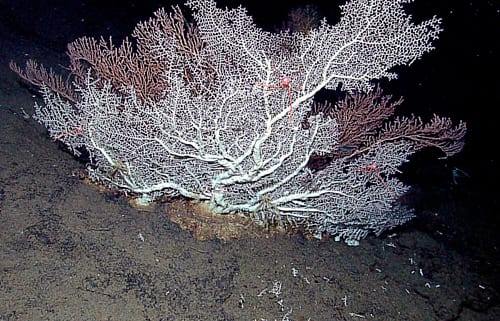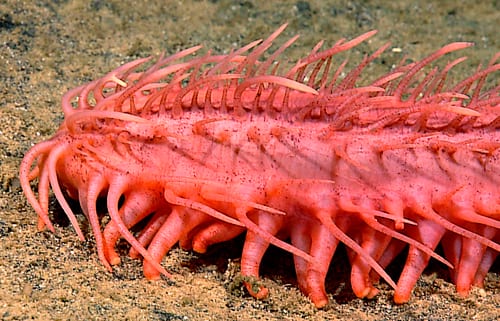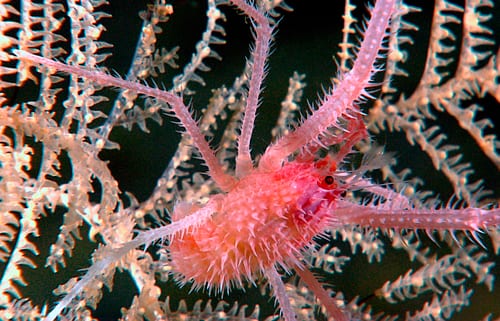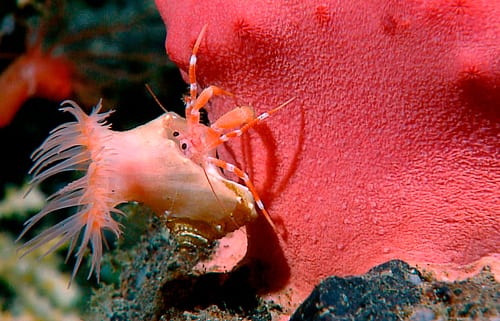- An expedition to unexplored seas off Indonesia during the summer of 2010 found diverse deep-sea habitats and marine life, such as this bubblegum coral covered by a parsitic zoanthid coral living on the bottom of the ocean at a depth of 1,588 meters. (Image courtesy of NOAA Okeanos Explorer Program INDEX-SATAL 2010)
- The expedition explored unknown ocean areas (orange boxes) in SATAL—a contraction of Sangihe and Talaud, two island chains stretching northeast of North Sulawesi. (Map adapted from Google Earth)
- U.S. and Indonesian scientists worked together on two ships—the U.S. National Oceanic and Atmospheric Administration's ship Okeanos Explorer, above, and the Indonesian research vessel Baruna Jaya IV. It was NOAA's inaugural deep-ocean exploration cruise using satellite communication to transmit real-time images from a remotely operated vehicle (being lowered into the ocean) to “exploration command centers” ashore in Seattle and Jakarta. (Image courtesy of NOAA Okeanos Explorer Program, INDEX-SATAL 2010)
- The remotely operated vehicle Little Hercules is tethered to the ship and is equipped with lights and camera systems to capture images and high-definition video from the seafloor and transmit them to the ship and to shore in real time, a technology referred to as “telepresence.” (Photo by Tim Shank, Woods Hole Oceanographic Institution)
- Lights from the ROV Little Hercules spotlight a “hotspot” of animal life on the seafloor 2,133 meters beneath the surface. (Image courtesy of NOAA Okeanos Explorer Program, INDEX-SATAL 2010)
- A navigator, pilot, and co-pilot constantly monitor Little Hercules and its camera systems aboard the Okeanos Explorer. Although the ship was thousands of miles away, scientists standing watch at shore-side “exploration command centers” throughout the country were able to guide the ship and Little Hercules through their mission. (Photo by Tim Shank, Woods Hole Oceanographic Institution)
- Tim Shank, a biologist at WHOI, explores deep-sea animal life. He invited Catriona Munro, an undergraduate biology student at University College London to be a volunteer in his lab during the summer of 2010. “He recounted to me more than once how there are points in our lives when people can make a meaningful difference,” Munro said, “and he is always looking for that opportunity to help people pursue their passions.” (Photo by Eleanor Bors)
- Catriona Munro (left), volunteered to spend the summer working in WHOI biologist Tim Shank's lab. She and Elizabeth Sibert (right), a WHOI Summer Student Fellow, became immersed in the research cruise to search for new deep-sea species in unexplored seas off Indonesia. They chronicled video captured by a remotely operated vehicle in the ocean depths, which was transmitted in real time to their laboratory outpost at WHOI. (Image courtesy of Woods Hole Oceanographic Institution)
- Watching a live video feed from the seafloor, Munro saw this large scleractinian hard coral, found 1,382 meters deep, which potentially has been growing for thousands of years. “It was so humbling to happen upon such an exquisitely beautiful and old coral,” she said. (Image courtesy of NOAA Okeanos Explorer Program, INDEX-SATAL 2010)
- Little Hercules' cameras captured this brightly colored, many-footed sea cucumber marching across the ocean floor. (Image courtesy of NOAA Okeanos Explorer Program INDEX-SATAL 2010)
- A spiny squat lobster clings to the branches of a black coral. Squat lobsters seem to be found only on a particular coral species, and Munro is particularly interested in studying these so-called host-associate relationships. (Image courtesy of NOAA Okeanos Explorer Program, INDEX-SATAL 2010)
- This image displays a four-way association between creatures: The hermit crab is associated with the big soft coral (with its polyps retracted). The hermit crab is also associated with an episymbiotic anemone. The snail shell provides a home to both animals. (courtesy of NOAA Okeanos Explorer Program, INDEX-SATAL 2010)
Image and Visual Licensing
WHOI copyright digital assets (stills and video) contained on this website can be licensed for non-commercial use upon request and approval. Please contact WHOI Digital Assets at images@whoi.edu or (508) 289-2647.
